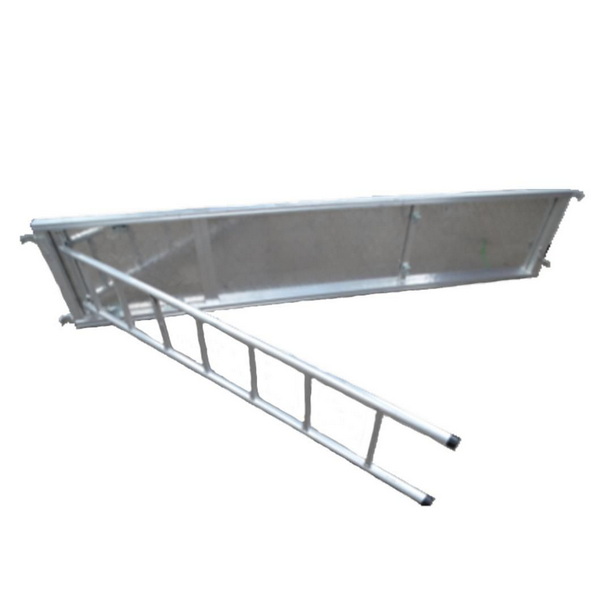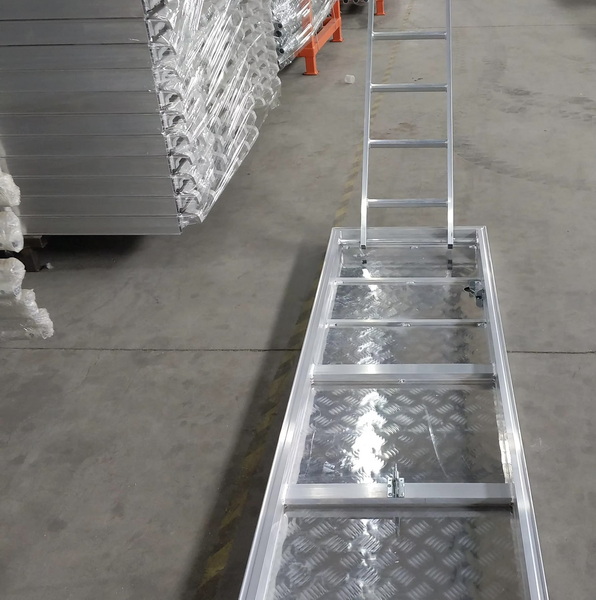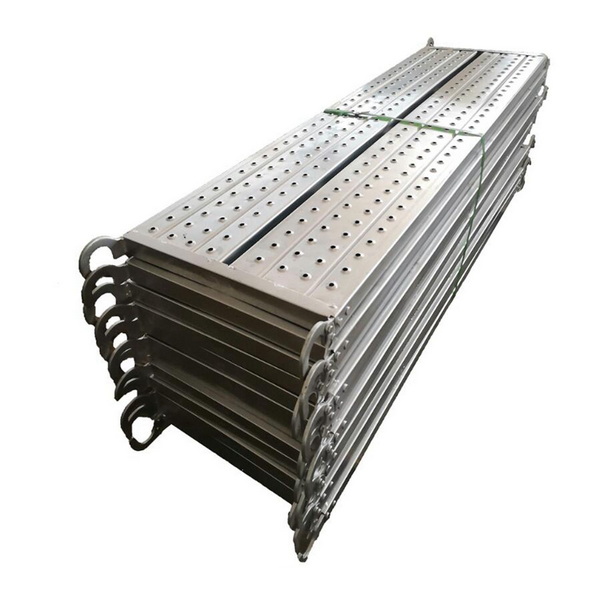Content Menu
● Introduction to Ladder Scaffolding Planks
● Types of Ladder Scaffolding Planks
● Safety Features of Ladder Scaffolding Planks
● Best Practices for Using Ladder Scaffolding Planks
● Common Hazards and Solutions
>> Hazards
>> Solutions
● Advanced Safety Technologies
● Case Studies: Successful Implementation of Safe Ladder Scaffolding Planks
● Regulatory Frameworks
>> OSHA Guidelines
>> SafeWork NSW Guidelines
● Conclusion
● FAQ
>> 1. What is the maximum weight capacity of a typical trestle ladder scaffold?
>> 2. How do I ensure safe access to a ladder scaffolding plank?
>> 3. What safety standards should I follow when using ladder scaffolding planks?
>> 4. Can I use a ladder as a platform for scaffolding planks?
>> 5. How often should I inspect my ladder scaffolding planks?
● Citations:
When it comes to working at heights, safety is paramount. One of the most critical components in ensuring a safe working environment is the ladder scaffolding plank. This article will delve into the world of ladder scaffolding planks, exploring their types, safety features, and best practices for use.

Introduction to Ladder Scaffolding Planks
Ladder scaffolding planks are designed to provide a stable platform for workers to perform tasks at elevated heights. These planks are typically used in conjunction with ladders or scaffolding systems to create a secure workspace. The safety of these planks is crucial as they are often used in industries such as construction, painting, and electrical work.
Types of Ladder Scaffolding Planks
1. Fixed Length Planks: These are the most common type and come in standard lengths. They are easy to set up and provide a solid platform for workers.
2. Telescoping Planks: These planks can adjust to different lengths, offering flexibility in various work environments. The Little Giant Telescoping Plank is a popular example, capable of holding two people with a maximum weight of 500 lbs.
3. Trestle Ladder Scaffolds: These are lightweight scaffolds supported by trestle ladders, often used for light-duty work. They are limited to a maximum weight capacity of 225 kg and are commonly used by painters and electricians.
Safety Features of Ladder Scaffolding Planks
Safety is the top priority when using ladder scaffolding planks. Here are some key safety features to look for:
- Weight Capacity: Ensure the plank can support the weight of the workers and any tools or materials.
- Material Quality: Planks made from durable materials like aircraft-grade aluminum are preferred for their strength and lightweight nature.
- Secure Attachment: The plank should securely attach to the ladder or scaffolding to prevent shifting or falling.
- Edge Protection: In many cases, edge protection is required to prevent falls from the platform.
Best Practices for Using Ladder Scaffolding Planks
To ensure safe use of ladder scaffolding planks, follow these best practices:
1. Proper Setup: Always set up the scaffolding according to the manufacturer's instructions. Ensure the surface is firm and level, and the platform is fully planked with no gaps exceeding 20 mm.
2. Regular Inspection: Regularly inspect the plank and scaffolding for any damage or wear. Replace any damaged components immediately.
3. Access Methods: Use secure access methods such as climbing the ladder cross-bearers or using an independent ladder that extends past the working platform.
4. Training and Licensing: Ensure that anyone erecting scaffolding holds the necessary high-risk work licenses, especially if the platform is more than 4 meters above the ground.
5. Weather Conditions: Avoid using scaffolding in adverse weather conditions such as strong winds or heavy rain, as these can increase the risk of accidents.

Common Hazards and Solutions
Hazards
- Falls: One of the most significant hazards is falling from the platform. Edge protection and secure access methods can mitigate this risk.
- Overturning or Collapse: Ensure the scaffolding is stable and erected on a firm surface to prevent overturning.
- Structural Failure: Avoid overloading the scaffolding beyond its weight capacity.
Solutions
- Regular Maintenance: Regularly check the scaffolding for any signs of wear or damage.
- Proper Training: Ensure all workers are trained in the safe use of scaffolding and ladder systems.
- Compliance with Standards: Adhere to local safety standards and regulations, such as those outlined by OSHA or SafeWork NSW.
Advanced Safety Technologies
In recent years, advancements in technology have led to the development of safer scaffolding systems. These include:
- Modular Scaffolding Systems: These systems allow for quick assembly and disassembly, reducing the risk of accidents during setup.
- Safety Nets: Installing safety nets around scaffolding can catch workers in case of a fall, reducing injury severity.
- Fall Protection Equipment: Personal fall protection equipment (PFPE) like harnesses and lanyards should be used when working at heights.
Case Studies: Successful Implementation of Safe Ladder Scaffolding Planks
Several companies have successfully implemented safe practices for ladder scaffolding planks, resulting in reduced accidents and improved productivity. For example, a construction company in Australia implemented regular training sessions and strict adherence to safety protocols, leading to a significant decrease in workplace injuries.
Regulatory Frameworks
Understanding the regulatory frameworks governing the use of ladder scaffolding planks is essential. In the United States, OSHA provides guidelines for scaffolding safety, while in Australia, SafeWork NSW outlines specific requirements for scaffolding setup and use.
OSHA Guidelines
- 29 CFR 1926.451: This standard outlines the general requirements for scaffolding, including design, construction, and use.
- 29 CFR 1926.452: This section covers specific types of scaffolding, such as suspended scaffolds and aerial lifts.
SafeWork NSW Guidelines
- AS 1576.5: This standard covers the design, manufacture, and testing of scaffolding components.
- AS 1892.1: This standard outlines the safe use of portable ladders.
Conclusion
Choosing the safest ladder scaffolding plank for work involves considering factors such as weight capacity, material quality, and compliance with safety standards. By following best practices and ensuring proper setup and maintenance, workers can minimize risks associated with working at heights. Remember, safety should always be the top priority in any work environment.

FAQ
1. What is the maximum weight capacity of a typical trestle ladder scaffold?
Trestle ladder scaffolds are generally limited to a maximum weight capacity of 225 kg, making them suitable for light-duty work.
2. How do I ensure safe access to a ladder scaffolding plank?
Safe access can be achieved by climbing the ladder cross-bearers or using an independent ladder that extends past the working platform. Direct access from an adjacent structure is also acceptable.
3. What safety standards should I follow when using ladder scaffolding planks?
Always follow local safety standards such as AS 1576.5 for scaffolding and AS 1892.1 for ladders. Ensure compliance with regulations like those from SafeWork NSW or OSHA.
4. Can I use a ladder as a platform for scaffolding planks?
Using a ladder as a platform is generally not recommended as it can obstruct safe access points for hands and feet. However, some scaffolding designs may allow this, but it should be done with caution and in compliance with safety standards.
5. How often should I inspect my ladder scaffolding planks?
Regular inspections should be conducted before each use to check for any damage or wear. This ensures the scaffolding remains safe for workers.
Citations:
[1] https://www.safework.nsw.gov.au/resource-library/scaffolding/trestle-ladder-scaffolds-fact-sheet
[2] https://www.youtube.com/watch?v=adpi1EZUJJ0
[3] https://www.sohu.com/a/229746319_498025
[4] https://www.littlegiantladders.com/products/ladder-plank
[5] https://www.youtube.com/watch?v=xNR3yeRowto
[6] https://www.bbc.com/learningenglish/chinese/features/q-and-a/ep-200318
[7] https://www.reddit.com/r/HomeImprovement/comments/4dwdaq/scaffolding_safety_question_can_you_place_a/
[8] https://www.youtube.com/watch?v=rHwVAudO1f8






















